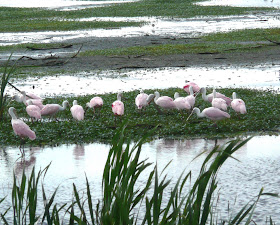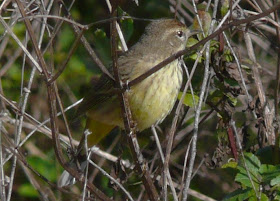Monday, February 21st
 |
| Roseate Spoonbills at STA5 |
Today was my anticipated trip to the Southwest Florida Water Management District's, Stormwater Treatment site #5 . Only organized, guided tours are permitted at this time to access the property for birding. Therefore I had contacted the Hendry - Glades Audubon Society to make a reservation to attend today's tour. STA5 is located about twenty miles south of Clewiston, and is about two hours from home.
 |
| American White Pelican at STA5 |
 |
| A concentration of Black-necked Stilts |
Today I am joined by my daughter Katie, who took many of these photos. On the trip over we spotted a pair of Scissor-tailed Flycatchers, a trio of Crested Caracaras and a Broad-winged Hawk. Had a report of a sighting of a white-tailed kite near STA5 and were watching for any newly arrived swallow-tailed kites. But no kites today though.
 |
| Great Blue Heron |
The tour today was very crowded. I believe there was a count of 83 people. So some of us were allowed to free-lance. We quickly found Purple Gallinules, a Purple Swamphen, hundreds of American Coots, Common Moorhens, Greater and Lesser Yellowlegs. Can add both Black-bellied Whistling Ducks and Fulvous Whistling Ducks. This time of the year wintering waterfowl are common, especially the coots. Today we located Blue-winged Teal, American Wigeons, Northern Shovelers, Mottled Ducks, Lesser Scaups and Ring-necked Ducks. Also had American White Pelicans, Caspian Terns, Pied-billed Grebes, Anhingas and Double-creasted Cormorants. A few months ago a great cormorant was found here.
Also can count about 35 Roseate Spoonbills, over 40 Limpkins and a couple of hundred Black Skimmers. Were able to add Least Sandpipers, Dunlins, Long-billed Dowitchers and Black-necked Stilts. Had all of the waders, including an American Bittern. Lots of Northern Harriers seen working the marshes, also three Snail Kites, a Merlin, Peregrine Falcon and several American Kestrels. Had several Savannah Sparrows and a suspect swamp sparrow. Best sighting of the day was the wintering Cassin's Kingbird. This same bird was seen here last year in the exact same location as today's sighting. The cassin's is a western bird not commonly seen in Florida.
Lots of alligators seen everywhere. A very docile Florida Garter Snake found sunning itself on the road had to be moved to proceed. And large Snapping Turtle was found basking beside a canal. After three hours it was time to head home. Passed through Clewiston and Alva on the way and was able to add White-winged Doves and Indigo Buntings at the Alva bird feeders and Brown-headed Cowbirds in Clewiston.
 |
| The burning of a sugar cane field |
My List from STA-5 (56)
Black-bellied Whistling-Duck, Fulvous Whistling-Duck, American Wigeon, Mottled Duck, Blue-winged Teal, Northern Shoveler, Ring-necked Duck, Lesser Scaup, Pied-billed Grebe, American White Pelican, Double-crested Cormorant, Anhinga, American Bittern, Great Blue Heron, Great Egret, Snowy Egret, Little Blue Heron, Tricolored Heron, Cattle Egret, Green Heron, White Ibis, Glossy Ibis, Roseate Spoonbill, Black Vulture, Turkey Vulture, Osprey, Snail Kite, Northern Harrier, Red-shouldered Hawk, American Kestrel, Merlin, Peregrine Falcon, Purple Swamphen, Purple Gallinule, Common Moorhen, American Coot, Limpkin, Killdeer, Greater Yellowlegs, Lesser Yellowlegs, Least Sandpiper, Dunlin, Long-billed Dowitcher, Caspian Tern, Black Skimmer, Common Ground-Dove, Belted Kingfisher, Cassin's Kingbird, Loggerhead Shrike, Tree Swallow, Northern Mockingbird, Palm Warbler, Savannah Sparrow, Northern Cardinal, Red-winged Blackbird, Boat-tailed Grackle
Other Sightings
Scissor-tailed Flycatcher, Broad-winged Hawk, Crested Caracara, Red-tailed Hawk, White-winged Doves, Indigo Bunting
 |
| Snapping Turtle |
 |
| Florida Garter Snake |



















































